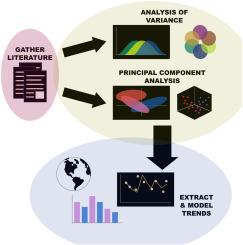全球水资源回收设施微塑料监测的荟萃分析:强调被忽视的因素
IF 7.3
2区 环境科学与生态学
Q1 ENVIRONMENTAL SCIENCES
引用次数: 0
摘要
由于城市水资源回收设施(WRRFs)是微塑料(MPs)与环境之间的重要渠道,因此了解全球趋势至关重要。该荟萃分析整合了来自世界各地的研究数据,提供了废水中MP的发生和去除的全面概述,同时强调了被忽视的变量和区域。主成分分析(PCA)发现,就MP去除性能而言,欧洲和亚洲在很大程度上形成了独立的集群,这可能是由于研究方法和纳入国家内财富范围的差异。亚洲的研究往往包括经济多样性更大的国家,而欧洲的研究总体上包括较小的MPs,更经常使用光谱学进行聚合物鉴定和定量。方差分析(ANOVA)确定了研究方法、二级处理类型和废水类型对全球和大陆的MP去除效果最显著(p值<; 0.01),而WRRFs内部和外部的其他变量根据社会经济视角(即,相对与绝对财富的国内生产总值,或人均GDP)施加不同的影响。事后分析发现,中国、韩国和越南在从其他亚洲国家移除MP方面表现出显著不同的方式。最后,采用成分回归(PCR)和基于机器学习的偏最小二乘回归(PLSR)建立了WRRF中MP去除的预测模型,该模型支持PCA和ANOVA识别的区域行为模式,同时简化了预测WRRF性能的有效方法。未来的研究应该解决全球监测偏差、塑料废物管理不善以及标准化的MP报告和分析。本文章由计算机程序翻译,如有差异,请以英文原文为准。

Meta-analysis on microplastics monitoring in global water resource recovery facilities: An emphasis on overlooked factors
As municipal water resource recovery facilities (WRRFs) provide an important conduit between microplastics (MPs) and the environment, it is critical to understand global trends. This meta-analysis integrates data from studies worldwide, providing a comprehensive overview of MP occurrence and removal from wastewater while emphasizing overlooked variables and regions. Principal component analysis (PCA) found that Europe and Asia form largely separate clusters in terms of MP removal performance, likely due to differences in study methodologies and the range of wealth within included countries. Asian studies tended to include countries of greater economic diversity, while European studies overall included smaller MPs and more often employed spectroscopy for polymer identification and quantification. Analysis of variance (ANOVA) identified study methodology, secondary treatment type, and wastewater type to have the most significant effects on MP removal (p-values <0.01) globally and continentally, with other variables both internal and external to WRRFs exerting varied effects depending on the socioeconomic lens (i.e., relative vs. absolute wealth in terms of gross domestic product, or GDP, per capita). Post hoc analysis identified China, South Korea, and Vietnam to display significantly different means in MP removal from other Asian countries. Lastly, component regression (PCR) and machine learning-based partial least squares regression (PLSR) were conducted to create prediction models for MP removal from WRRFs, which supported the regional patterns in behaviour identified with PCA and ANOVA while streamlining an efficient method for predicting WRRF performance. Future research should address global monitoring bias, mismanaged plastic waste, and standardized MP reporting and analysis.
求助全文
通过发布文献求助,成功后即可免费获取论文全文。
去求助
来源期刊

Environmental Pollution
环境科学-环境科学
CiteScore
16.00
自引率
6.70%
发文量
2082
审稿时长
2.9 months
期刊介绍:
Environmental Pollution is an international peer-reviewed journal that publishes high-quality research papers and review articles covering all aspects of environmental pollution and its impacts on ecosystems and human health.
Subject areas include, but are not limited to:
• Sources and occurrences of pollutants that are clearly defined and measured in environmental compartments, food and food-related items, and human bodies;
• Interlinks between contaminant exposure and biological, ecological, and human health effects, including those of climate change;
• Contaminants of emerging concerns (including but not limited to antibiotic resistant microorganisms or genes, microplastics/nanoplastics, electronic wastes, light, and noise) and/or their biological, ecological, or human health effects;
• Laboratory and field studies on the remediation/mitigation of environmental pollution via new techniques and with clear links to biological, ecological, or human health effects;
• Modeling of pollution processes, patterns, or trends that is of clear environmental and/or human health interest;
• New techniques that measure and examine environmental occurrences, transport, behavior, and effects of pollutants within the environment or the laboratory, provided that they can be clearly used to address problems within regional or global environmental compartments.
 求助内容:
求助内容: 应助结果提醒方式:
应助结果提醒方式:


